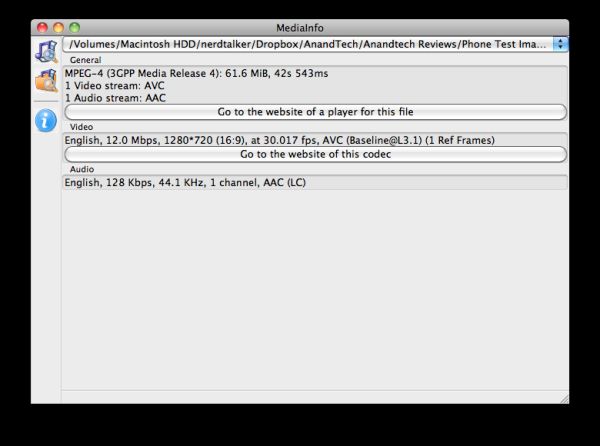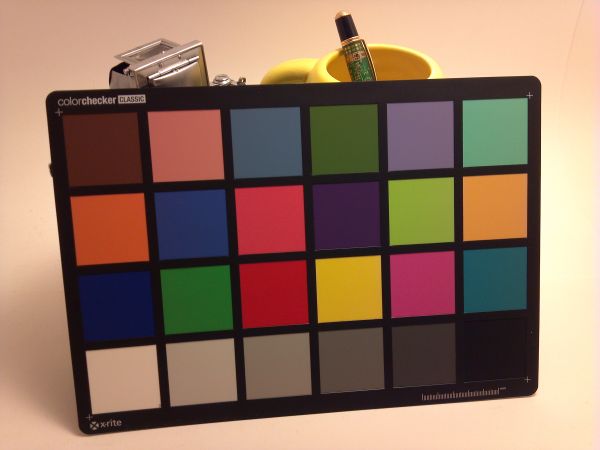Motorola Droid X2 Review - A Droid X with Tegra 2
by Brian Klug on July 7, 2011 8:31 AM ESTCamera - Upgraded
Captured image quality is getting better with time, thanks to both improved image signal processing (ISP), software, optics, and of course sensors. Thankfully the X2 brings the entire package of improvements to the table. First off, the most obvious difference is that the mechanical shutter is gone (whose purpose I never quite understood), and the first vertex of the camera seems to have a larger diameter, meaning it has improved light collection over the X.
The original X was one of the first smartphones we tested with 720p video capture after the iPhone 4 made its debut. At that time, the X captured 720p24 8 Mbps MPEG-4 video with 1 channel 96 Kbps AAC audio. The X2 bumps video capture up to 720p30 H.264 at 12 Mbps with 128 Kbps single channel AAC audio.
Obviously the Tegra 2 SoC inside the Droid X2 could capture at 1080p, but we’d honestly rather see high quality 720p like the X2 shoots over lower bitrate 1080p. Honestly, 1080p still remains a checkbox feature today until bitrates get higher or encoders get better.
I initially noticed a serious problem with video capture on the X2. Set to capture to the external SD card (by default), video had second long dropouts and stalls, like this. Around 12 and 19 seconds, the fun starts:
On the device itself, capture would correspondingly pause, hang, and even crashed once. I shot two or three videos to confirm to myself that it wasn’t just a fluke, and also closed every application to see if RAM consumption was a problem. After some googling and discovering similar complaints on forums, I stumbled on the problem - set the capture destination to internal storage, and the stuttering goes away. I went and re-captured the video, and boom, no stuttering:
What’s curious about the whole thing is that the card shouldn’t be the problem. I tested the 8 GB class 4 microSD card inside the X2 (which comes preinstalled) in a new USB 3.0 Lexar card reader with CrystalDiskMark and found that it had sequential writes of just over 5 MB/s. Far more than the 1.5 MB/s which would be required for the X2’s 720p video + audio stream. Testing with a 32 GB class 2 resulted in no stuttering, and after a format the supplied microSD card went back to not stuttering. Either way, if you experience problems, switch to internal storage, format the external, or get another microSD card.
The X2 includes an 8 MP camera with dual LED flash, just like the previous X. However, there’s more to image quality than just MP numbers, which would have you thinking that everything is the same.
Still image quality on the X2 is improved from the original Droid X. In some ways it’s considerably better, others the same.
White balance in our lighbox test is a bit warm, as are a few outdoors test shots. There’s some chromatic aberration at the extreme angles in the lightbox test as well, evidenced by the red circle around the image. That said overall sharpness seems better.
What I miss from the Droid X is that camera button, which (as I mention in the video review) Motorola seriously emphasized the first time around as a distinguishing feature for the X. The problem isn't so much that it's gone as it is that the camera software now relies on an awkwardly placed software capture button. What I mean is that the X2 uses the exact same camera UI as the original X, which obviously was tailored around using the shutter button instead of the software shutter button. As a result, more often than not I would press near (but not on) the button and just toggle the OSD instead of taking a photo.






































72 Comments
View All Comments
anandatar - Thursday, July 7, 2011 - link
So yeah, I know, Anandtech is a US blog.Still I'm surprised there is no comparison to the Galaxy S 2 - I was already surprised before by this but nothing has changed.
The main reason is because ALL the phones in the comparison look pale when compared with the S2.
It's (much) faster than any of the Tegra2 based devices.
It has more ram.
It's (much) lighter (there's no xperia either)
It's (much) thinner (there's no xperia either)
it's camera still picture is second to the N8 only
it's camera video recordings are above average (not blowing others out of the water tho - in 1080p it's zoomed and focusing is slower - in 720p its awesome)
it's battery life is (much) improved too
in fact, on the paper, only the resolution (800x480) is lower than the other phones (that sometimes have qHD)
Not only that, but it's also the first phone I'd use instead of an iPhone - it's that much better that it makes sense to switch. But I wouldnt settle for less.
jmcb - Thursday, July 7, 2011 - link
Glad you like the GS2 so much....If you know all this, why do you need to see a comparison? Check other sites, they do compare the GS2 with other phones...Imma help you out.... phonearena is one site that does. phonedog is another...
NeoteriX - Thursday, July 7, 2011 - link
You mentioned in your HTC Sensation review that with a little digging, you were able to come up with the camera sensor used there -- "Samsung’s 8 MP S5K3H1GX 1/3.2” 3264x2488 CMOS sensor with 1.4 µm square pixels "Though the sensor isn't the only thing as you mentioned (lens, etc.), it's useful to compare stated sensitivities, pixel sizes, etc. across the different current phones as well as generationally. I still feel like the gold standard is the iPhone 4 with its 1.75 µm pixel sites and BSI Omnivision sensor.
Do you have this information for the Droid X and X2? How does one generally determine this? I'd love to be able to figure it out for my Evo 3D.
munky - Thursday, July 7, 2011 - link
Iphone4 is by no means the gold standard. Also, there's plenty of variables affecting sensor performance which wouldn't be obvious just by looking at pixel pitch, not to mention how the image processing algorithms affect the final outcome. Unless you suggest AT start evaluating sensors with RAW data a la dxomark, I'd much rather they focus on comparing actual photos as opposed to numerical specs.NeoteriX - Thursday, July 7, 2011 - link
I agree that specs aren't the whole picture, but I do think it provides useful insight to augment the results one sees in practical testing -- things like being able to tell how much of the improvement is image processing, what generation the sensor is and recently of development, and seeing if improving the image quality/sensors used is actually a priority for certain manufacturers. More information never hurts and it helps understand the story -- for example, when digital cameras were undergoing the megapixel race one or two years ago, it was clear that low light quality was degrading and pixel sites helped explain that story.At any rate, I'm no expert on the state of cellphone cameras, but I will respectfully disagree with you on the iPhone 4 -- no other non-camera-phone smartphone (i.e., the Sony/Nokia/etc. type phones with real digital camera level optics and sensors built in, xenon-flashes the whole 9 yards) *I've seen* has the kind of low-light sensitivity and all-around flexibility of the iPhone 4.
It's likely a combination of the relatively large sensor sites, the large fixed aperture of the lens, the BSI CMOS design, and good image processing, but Android mfrs still have their work cut out for them over a year after the iPhone 4 release -- I'd be interested in hearing what other phone is better in low-light and all-around capability, because I certainly haven't seen it.
Exodite - Thursday, July 7, 2011 - link
The new Xperia series (arc/neo/pro/play) seems a good fit, especially considering that the iPhone 5 is slated to use the same sensor as those handsets.Anyway the criteria you use for comparison are rather humorous, as it reads like the iPhone 4 having the best camera - as long as you disregard those that are better?
HTC is generally known to ship shitty cameras but I'd say both foo, bar, beep and bloop - to name those at the top of my mind - offer some excellent solutions for those who want decent images from their smartphones.
(As a side note to Anandtech - your spam filter sucks! Horribly.)
Exodite - Thursday, July 7, 2011 - link
Feel free to replace foo, bar, beep and bloop with the names of big smartphone manufacturers that aren't HTC.I would do it myself, if that wouldn't mean getting caught in the spam filter.
NeoteriX - Thursday, July 7, 2011 - link
That's fair although I wouldn't call my criteria bogus ;)The vast majority of cell/smartphones are those built around sensor/lens/IC SOCs primarily built for mobile applications, they feature LED-based flashes--in essence, they are known to be significant compromises in the world of digital imaging because they are, in other words, phones first, cameras second.
Then, there is a small minority of cell phones that are essentially cameras with phones attached to them -- SonyEricsson C-902, Nokia N82, etc. that feature sensors and lenses pulled from traditional cameras, but with phone functionality -- we're talking about large sensors, camera glass, and xenon flashes intended for P&S digital camera applications and not mobile.
I've heard good things about the new Xperia Arc with the Exmor R BSI sensor, but it hasn't been released in the US yet and neither has the iPhone 5... thus my position that the iPhone 4 leads the pack.
Exodite - Thursday, July 7, 2011 - link
I would say my arc does decent pictures, though perhaps I'm spoiled by the fact that my better half uses a Nokia N8. Color accuracy is good but the focus area is unfortunately very narrow which makes the pictures less good than they could be.The Samsung Galaxy S2 is arguably better, end results considered.
Anyway, I hope the iPhone 5 does end up using the same sensor as the Xperia line as it'd be interesting to see what a different hard/software solution would do with the same sensor.
Then there's stuff like the Motorola Milestone which also have a great camera, considering.
Would an N8 qualify, or is that too a camera first?
Because from my standpoint I can see something like the Altek Leo being a camera first and phone second but I'd still consider anything in a normal housing to be a phone first.
munky - Thursday, July 7, 2011 - link
Have you seen the photos taken with the Nokia N8? They are cleaner that those from iphone4, not to mention more natural looking due to lack of over-sharpening and over-saturation. The iphone4 may be good compared to a crappy phonecam, but it is definitely not the best.